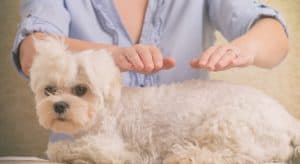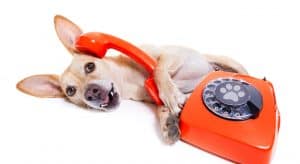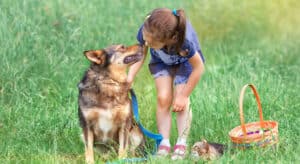All dogs are capable of being aggressive as it’s part of their DNA to survive. Just look at your dog’s lovely teeth when they smile at you! You don’t inherit those pearly whites from being a timid little creature. Before dogs were domesticated they had to be aggressive in order to survive. Consequently, this involved fighting for scarce food and resources against other packs, and only the strong survived so aggression is a natural part of a canine’s defenses.
Nowadays thankfully domesticated dogs no longer have to fight for survival by being aggressive but canine aggression can still possibly rear its ugly head. Aggression can arise when a dog is faced with a situation or predicament that it cannot handle and its stress levels increase substantially. This build-up of stress leads to physical and psychological distress that can in turn result in destructive and aggressive canine behavior. From the dog’s perspective, it is either flight or fight and on many occasions, aggression will come to the fore. I guess you could say the same about humans too.
Although every dog has the potential to be aggressive this type of behavior is not shown by all dogs. You can even prevent this aggressive behavior from occurring in the first place. Although sometimes this is not always possible you can still take steps to deal with any dog aggression so that it does not get out of hand.
There are 2 main types of Dog Aggression
- Dog Aggression Towards Strangers
- Dog Aggression Towards Family Members
What causes each of these 2 types of dog aggression is different and there are different ways of dealing with and treating each type of aggression
.
1. Dog Aggression Towards Strangers
When a dog is nervous around people it is definitely noticeable in his body language. He will be fidgeting about and will not stay easy. He may stare at the stranger and even make a deep rumbling growl, his tail may be lowered between legs and there is a general air of discomfort and anxiousness.
.
Why Does Your Dog Behave Like This Around Strangers?
Dogs can behave like this around strangers as they are simply not used to this experience of meeting people they do not know. Dogs rely on their owners to show them the world and introduce them to new things and new people and even new dogs.
From a dog’s perspective, they do not know this new person and consequently, they are unsure if they are a threat or not. With encouragement and positivity on your part, your dog will learn that not everybody is a threat or danger. With consistent and positive daily experiences, dogs just like people will build confidence and learn that not everything new is bad news and scary.
You need to be patient and offer reassurance to your dog and teach him that new things and “new” people are not a threat. It will take time but ensure your dog has a positive experience around these new things as it will help the next time he meets them. In this way, he will soon learn it’s ok to relax and not be scared or intimidated and consequently not be aggressive in these situations.
.
How Can You Help Your Dog?
The buzzword here is socialization. This is defined as the activity of mixing sociably with others. Get your dog used to the outside world with its strange sounds, shapes, smells, and people and machines. Sometimes we forget how intimidating the outside world can be with all the noise and hustle and bustle. In addition, most dogs will experience these outside events at a different eye level to humans so that needs to be taken into account.
As early as possible start to socialize your dog and introduce him to all these new and wonderful experiences. From your dog’s perspective, it’s a whole new world out there. Make it fun and your dog’s confidence will grow. A confident dog makes a content dog.
.
Does Socialization Prevent Dog Aggression Towards Strangers?
Yes, socializing your dog is a great way to prevent dog aggression towards strangers. With socialization it’s not just about taking your dog into a busy shopping district and walking around people and places to show him all the new sights and sounds and then walking home with him again. You might start off with a walk to a busy area and wait by his side. Give him reassurance. Let him watch the passing parade of people and get him used to the strange sounds, smells, and even the look of all the different types of people.
Socialization will also involve your dog getting a chance to meet and greet new people. Start slowly and be relaxed. Just have your dog by your side as you chat with somebody unfamiliar to your dog. Try and have your dog meet as many types of animals and people. The more people you meet and greet with your dog the more he will become accustomed to new people and places. The outside world will slowly start to become a less scary place for your dog as his confidence grows.
2. Dog Aggression Towards Family Members
When your dog is aggressive towards other family members it can be quite upsetting and often family members will not know how to handle it. A dog that is aggressive at home will also be most likely aggressive to strangers too. In order to get to the bottom of this aggression problem we first need to look at the reasons why your dog could be aggressive towards family members.
- Defending his so-called possessions from threats like you and other family members, more commonly known as resource guarding
- Your dog is not satisfied with how he is being treated by you and other family members.
- He has never been trained to understand his position within the pack or family.
.
What is Resource Guarding?
Resource guarding is quite common among dogs showing aggressive traits and it’s when the dog is overly possessive of an item and will not allow you to take it or even touch it. This behavior may involve snarling, snapping, and maybe even give you the “evil eye” – the direct canine translation “don’t you dare touch this, hands off – it’s mine!”
Resource guarding can happen when your dog has a toy or any household item in his position. It can also occur with food and treats.
.
Why Does Resource Guarding Occur?
The whole issue of resource guarding has to do with dominance. By their very nature dogs are pack animals. They do not live solitary lives but instead belong to a pack. Before domestication, they lived in packs and each dog knew exactly where his position with the pack was. This hierarchical structure meant that each dog knew how to act and interact with others. For example, a dog in a higher rank would eat before others and would not tolerate a younger dog jumping the line for food. The lower-ranked dog would be “put in its place” by aggressive behavior such as a snarl, growl, etc. This is the way the lower-ranked dog would be disciplined.
It would be inconceivable for a lower-rank dog to show aggression or act dominantly towards a higher-status dog as this type of behavior would not be tolerated and there would be serious repercussions.
Resource guarding is a dominant behavior shown by higher-ranking dogs to protect their possessions. If you have experienced this type of dominant canine behavior within the household then it’s pretty clear where your dog ranks your position within the family pack, at a lower level than his. Obviously, this is something you need to change as otherwise, your dog will think he is the boss of the entire household. We have outlined some steps below to deal with this behavior.
.
How To Deal With Dog Aggression?
Dealing with dog aggression will take plenty of patience and perseverance. The best approach is to be consistent with dog obedience training. This will show your dominance in the pack and very soon your dog will realize there is a “new sheriff in town and he means business.” I don’t think you need to wear a badge as your dog will soon learn who’s the new boss with this training. Initially, he may look at you with some strange stares but be persistent and consistent with training.
Make sure you undertake some obedience training at least two times every day for 10/15 minutes. By training your dog he will come to the realization that you are in charge and that it is worth his time obeying your commands as you have all the tasty treats and you also lavish praise when he behaves. And for those times when he misbehaves then there are consequences such as time outs and no treats.
For dogs who are overly aggressive or if you are not confident enough to train the dog yourself then it might be worth investing in the services of a qualified dog trainer. In addition have a consultation with your veterinarian as there could be some underlying medical condition.
Further Information
Dealing with aggressive and dominant dog behavior is definitely challenging but it’s well worth the effort as unfortunately, the prospects for an aggressive dog are not good especially if placed for adoption. Very few people will adopt a dog that shows aggression.
For detailed information on how to handle dog aggression and dominant behavior along with other canine behavioral issues, check out Secrets to Dog Training. It’s a complete owner’s guide to owning, rearing, and training your dog, and it deals with all aspects of dog ownership and is well worth a look.







